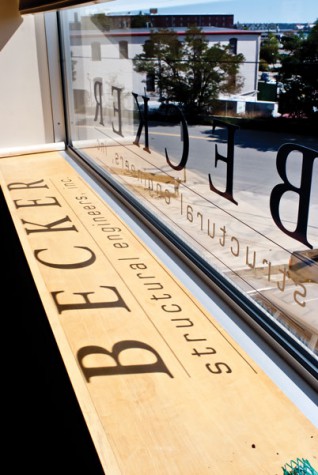Structurally Sound
PROFILE-November/December 2010
by Victoria Scanlan Stefanakos
Photography Sean Alonzo Harris
Engineer Paul Becker loves architecture almost as much as the science behind it
Most design dream teams in these parts seem to include Paul Becker. High-minded architects like Sam Van Dam, Rick Renner, Winton Scott, and Matt Elliott (of Elliott + Elliott Architecture) count his keen design sensibility, his pleasant personality, and his doodling among the many reasons why they call on Becker Structural Engineers when their designs need extra strength guidance.
As buildings open up—fewer walls, more windows—architects rely on an expert eye to ensure they will withstand not only the laws of physics but Maine’s rugged weather. Becker is their go-to engineer because he is a lot like them. While he specializes in the nuts and bolts of buildings, he loves helping design them, too. “He can problem solve in a way that architects can problem solve,” explains Sam Van Dam of Van Dam Architecture and Design. “He’s a great collaborator, and he draws better than most architects I know. Besides, I’ve gotten to the point where I don’t work with people I don’t really like anymore. Paul is just a pleasure to be with.”
Fifty-two-year-old Becker grew up in rural Bucks County, Pennsylvania, and remembers traveling to Philadelphia with his grandparents, who banked at the iconic PSFS Building on Market Street. Though he was only eight at the time, he realized then that buildings could make a powerful impact: They could not only stand tall and offer shelter; they could make you feel something. From then on, he loved architecture—and tinkering. Stranded lawnmowers found their way home with him, where he rebuilt or repurposed them. “I think we’re all builders, by nature. I built motors, growing up, because that’s what I had.” A two-year class in high school introduced him to drafting and design, which his teacher encouraged him to pursue. By the end of the course, he had built a model of his dream house.
“To me, seeing how things work and solving problems was everything,” Becker says. “I love being an engineer; it’s probably a better fit for me. I can appreciate architecture. I understand it. But I’m more concrete. I like the right and wrong of engineering. An architect is a grand conceptualist. We figure out how an idea becomes bricks and mortar.” By “we,” Becker means the sixteen people who form his team and juggle the firm’s wide-ranging work, from the Portland Public Library and Bates College’s Hedge Hall renovation to high-end homes, commercial buildings, and bridge projects all over New England. The breadth of their work helps them learn from one another. Becker Structural Engineers is now the largest structural engineering firm in the state. But building it has taken skills he didn’t know he had. Becker studied civil engineering at Penn State (architecture was a five-year program he wasn’t sure he could afford), and then earned his master’s degree in structural engineering from the University of New Hampshire. Early jobs in nuclear power plants and paper mills led him to a small structural engineering firm in Delaware, where he saw what it takes to run the business of engineering. “How do you know if an engineer is an extrovert?” Becker asks with a grin, jumping to his feet. “He looks at your shoes instead of his own.” (He loves that joke.) The truth is, Becker says, it took prodding and persistence fifteen years ago to call architects who had never heard of him. Once they got to talking, though, he loved the connection.
“It’s really about getting to know people as friends and talking about our lives. That’s what matters,” says Becker. His “life” includes his wife, Mary, and three teenaged children. They spend plenty of time together outdoors, cycling in warmer months and Nordic skiing in winter. Rick Renner, owner of Richard Renner Architects in Portland, has known and worked with Becker for nearly seventeen years. They have collaborated on all kinds of projects, from institutions to residences—even Renner’s own home and office in a former warehouse on Pleasant Street in Portland. “I love working with him for a couple of reasons. One, he’s still as excited about structural engineering as we are about architecture. You can feel that excitement when you put a team together,” Renner says. “He’s also very knowledgeable about architecture. When we’re designing, we’re trying to tell a number of stories, among which is ‘How is this building held up?’ Paul really engages in the design process.”
While the architects he works with are planning for flow, space, and “adjacencies” (which functions need to work together), Becker isn’t. He is serving as the structural engineer, nominated by his peers, on a twelve-member advisory board to develop Maine’s first statewide building code, which will go into effect in December. He’s also studying building materials, which are getting smarter, greener, and stronger. Those improvements allow for fewer solid walls—and big, open spaces. “Buildings aren’t as straightforward as they used to be, and homeowners have very high expectations. They don’t want to hear creaks in floorboards. They want it to be rock solid,” Becker says. “Sites here can be tricky, too: rock, tough clay soil that may settle, dramatic slopes. And then there are the islands…” For all of those reasons, Becker and his team encourage architects to come to them early with a rough idea of what they would like to do. That way, they can point out issues that may arise—before they end up costing more to fix. Becker and the architects he works with convey ideas (and find compromises) by doodling on tracing paper, or napkins. Even so, construction is a tough business. Things go wrong. When they do, Renner says, Becker rolls up his sleeves. Without animosity or blame, he dives in to solve them. In the mechanics of building, that may be his most valuable tool of all. “Architecture is not a big money-making activity for most of us,” says Renner, who also skis and cycles with Becker. “But part of the reward is the chance to collaborate with thoughtful, creative, and enjoyable people. Like Paul.”















